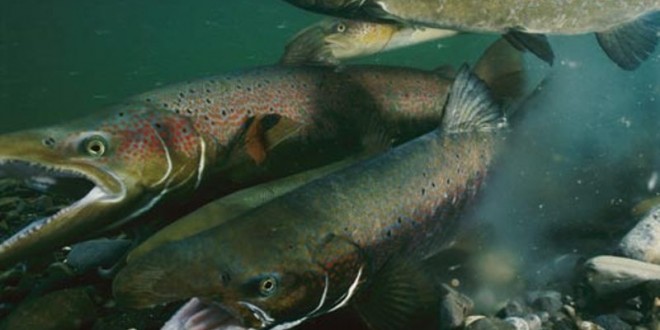New evidence has emerged in Alaska that early primitive communities fished for salmon in what is now North America.
Alaskan scientists have found that primitive cavemen fished for salmon during the Ice Age in North America. The Paleolithic Indians were basically hunter-gatherers. The men hunted for wild game and fish while the women collected berries and other roots and nuts.
The findings counter traditionally held beliefs that Ice Age Paleoindians were primarily big-game hunters. The findings are based on an analysis of 11,500-year-old chum salmon bones found by University of Alaska Fairbanks anthropologist Ben Potter and colleagues at the Upward Sun River site. Excavation has revealed human dwellings, tools and human remains, as well as the salmon bones.
“Salmon fishing has deep roots and we now know that salmon have been consumed by North American humans at least 11,500 years ago,” said lead author Carrin Halffman, a UAF anthropologist who helped analyze the fish bones with co-authors Brian Kemp of Washington State University, Potter and others.
The findings also suggest that salmon spawning runs were established much earlier and much farther north than previously thought – at the end of the Pleistocene epoch, also known as the last Ice Age.
Ancient DNA identifies chum salmon
Kemp, an anthropologist with extensive experience studying ancient DNA, led the genetic study using techniques developed at WSU to identify the remains to the species level. The age of the remains made studying them particularly difficult, he said: “There are few laboratories in the world that could successfully conduct such a study.
“Challenges aside, the antiquity of the remains reveal the earliest evidence of salmon exploitation by Native Americans,” he said. “The combined genetic and isotopic data demonstrate that predictable chum salmon runs were occurring from the Pacific Ocean to the far interior of Alaska by at least 11,500 years ago.”
Humans could have come to rely on such resources annually, he said.
“This sets up a scenario in which these abundant salmon could have been processed and stored, although for this we have no evidence yet,” he said. “Nevertheless, salmon exploitation was being conducted by humans that have been traditionally viewed more as hunters of big game, like mammoths and bison.”
The ancient DNA and stable isotope analyses verified the fish remains as sea-run chum salmon that migrated upriver nearly 900 miles from where the mouth of the Yukon River now exists. These analyses indicate that modern salmon migrations may have ancient roots, dating back to at least the end of the last Ice Age.
“We have cases where salmon become landlocked and have very different isotopic signatures than marine salmon,” Potter said. “Combining genetic and isotopic analyses allows us to confirm the identity as chum salmon, which inhabit the area today, as well as establish their life histories. Both are necessary to understand how humans used these resources.”
Delicate fish bones pose a challenge
The salmon were found in an ancient cooking hearth in a residential structure.
Fish remains pose a challenge to archaeologists because their bones are small, fragile and typically do not preserve well. Because of these challenges, their remains likely are underrepresented in global archaeological studies and findings.
The findings show that ancient Beringian diets were broader than earlier thought and that Ice Age humans used complex strategies and specialized technology to obtain their food, Potter said.
He said there is no evidence to suggest that salmon runs weren’t also present in the area a few thousand years prior to the time when people were living at the Upward Sun River site: “This suggests that salmon fishing may have played a role in the early human colonization of North America.”
The excavation and analyses were funded in part by the National Science Foundation. Other contributors to the paper include UAF postdoctoral researcher Holly McKinney, Bruce Finney of Idaho State University and Antonia Rodrigues and Dongya Yang of Simon Fraser University.
Agencies/Canadajournal
 Canada Journal – News of the World Articles and videos to bring you the biggest Canadian news stories from across the country every day
Canada Journal – News of the World Articles and videos to bring you the biggest Canadian news stories from across the country every day



